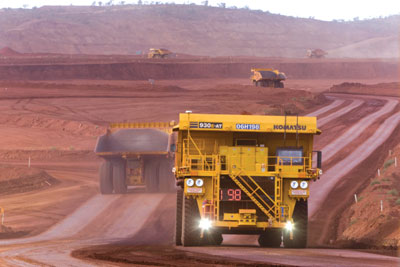 Responding to the industry’s need to reduce mine operating costs, Komatsu will offer data analysis services based on information collected from its mobile mining equipment. The machine data will be processed at a GE data analysis center in the U.S. Results will be used to recommend vehicle operational changes for increased efficiency.
Responding to the industry’s need to reduce mine operating costs, Komatsu will offer data analysis services based on information collected from its mobile mining equipment. The machine data will be processed at a GE data analysis center in the U.S. Results will be used to recommend vehicle operational changes for increased efficiency.As an indication of the rapidly rising importance of data analysis as a means to maximize expensive production-equipment performance, two of the mining industry’s largest earthmoving machinery suppliers recently announced Big Data-related collaboration efforts.
Komatsu announced a partnership with General Electric (GE) to provide Big Data analysis services for mining customers, using Internet of Things (IoT) technology to boost efficiency in mining operations. This follows an earlier agreement in February 2014, when Komatsu and GE Transportation announced a joint venture called Komatsu GE Mining Systems LLC to develop a new generation of underground mining equipment.
IoT refers to a growing global network of physical objects—including machines—embedded with electronics, software, sensors and connectivity. This enables them to achieve greater value and service by exchanging data with manufacturers, operators, other machines and other connected devices. Each thing is uniquely identifiable through its embedded computing system, but is able to interoperate within the existing Internet infrastructure.
GE is using IoT technology to constantly monitor critical equipment such as aircraft engines and gas turbines. Komatsu also makes use of remote monitoring technology through its KOMTRAX and KOMTRAX Plus offerings to track the position and status of its mining and construction machinery. GE has long supplied electric drive systems to Komatsu for use in the equipment supplier’s larger haul trucks.
Komatsu Australia’s Managing Director, Sean Taylor, said, “We want to start offering data analysis services to mining and resources companies in the near future, including iron ore and coal mines in Australia as well as other mining regions. With the current downward pressures on commodity prices, mining companies are looking for innovative ways to reduce their operating and running costs, while optimizing productivity and machine performance.”
Komatsu and GE said they have successfully trialed the concept over the past year at a copper mine in South America. Under the new partnership, Komatsu will send operational data collected from sensors attached to its mining haul trucks to a GE data center in the U.S., where it will be processed using GE’s data analysis capabilities.
Applications for the resulting information including recommending optimal truck routes and positioning, as well as speed and braking requirements based on the terrain and site conditions. Additional control equipment can also be installed to increase fuel efficiency.
“Existing data analysis capabilities already available through Komatsu allow fuel efficiency to be improved by 5% through more efficient truck scheduling and haul road management,” said Taylor.
“Now, by harnessing IoT technology, combined with GE’s data analysis capabilities, we can lift that figure to significantly greater than 10%, potentially saving millions of dollars a year per mine in fuel and other costs.
“There will also be flow-on benefits in terms of optimizing production, reducing equipment wear and tear, and maximizing machine uptime,” he noted. “By giving our mining customers access to such detailed operating information, Komatsu and GE together will provide opportunities for customers to reduce fuel and power usage, as well as optimizing shipments between mines and ports. We believe we can also help lower costs by reducing the stockpile volumes and holding times.”






